
A Guide for Hawaii Employers: How to Make Remote & Hybrid Working Work

A Guide for Hawaii Employers
How to Make Remote & Hybrid Working…Work
This guide helps employers consider some of the high-level remote and hybrid working trends affecting workplaces across the U.S. – and what these trends mean for Hawaii organizations. Bookmark this page for tips, advice, resources, and more!
April 2023
PART ONE
The Rise of the Employee Experience
What it is, how employee experience differs from employee engagement, and why you should care
If the 2010s was the decade of employee engagement, the 2020s is the decade of the employee experience. While “employee experience” used to be synonymous with “employee engagement,” today, the phrase has a broader scope. In a 2020 LinkedIn survey, 94% of respondents cited that the employee experience will be “very important” to the future of HR and recruiting.
What is Employee Experience?
While employee experience may be a newer term, it isn't a new concept. You're most likely familiar with the idea but in a different context: your customers! Over the last few decades, businesses have invested countless hours and manpower into customer listening, segmenting projects, and new programs seeking to engage and compete for customers' attention. Mastering the employee experience is no different. Considering the difficulties employers face with attracting and retaining top talent, it’s critical for leaders to apply the same strategic rigor and focus as they would on their customers, on their employees.
So, what is the employee experience? In a nutshell, it can be explained as:
Your employee’s holistic perception or feeling caused by the one-off and cumulative effect of interactions with your business, leaders, processes, and policies across the entire employee lifecycle – from recruiting and onboarding, retaining and developing, all the way through separating and offboarding.
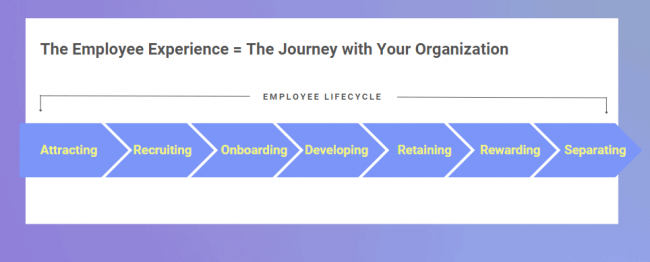
Employee Experience vs. Engagement
Although employee engagement and employee experience are inextricably linked, there are unique differences. While employee engagement has become a short-term fix focused on perks to make employees happy, employee experience is a strategic and long-term effort focused on redesigning organizational processes to put people at the center. From hiring and onboarding to day-to-day interactions with colleagues, companies that identify, design, and deliver thoughtful interactions between employees and the business by aligning employee needs/wants to make real gains over ones that only focus on employee engagement programs.
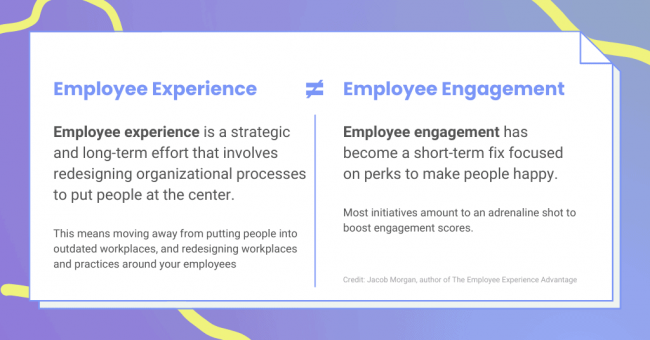
Why Care?
There's a strong business case for mastering the employee experience. According to Jacob Morgan, author of The Employee Experience Advantage, companies that invest in employee experience outperform those that don’t. In fact, they’re 4X more profitable and grow 1.5X faster, according to his analysis of 250 organizations.
“Customers will never love a company until its employees love it first” - Simon Sinek
Takeaways:
- Employee experience is not the same as employee engagement
- Employee experience is your employee’s holistic perception of the business from one-off and cumulative interactions across the employee lifecycle
- Organizations that invest in creating a positive employee experience are more successful than those that do not

PART TWO
Four Key Employee Factors That Affect Employee Experience
How generation, career experience, tenure with company, and leadership responsibilities affect the employee experience in remote & hybrid workplaces
As more companies shift from in-person to hybrid and remote work, it's become clear that employee and employer perceptions of these arrangements are wide-ranging. Many workers crave flexibility and empathy from their employers, according to multiple studies. On the other hand, experts are predicting that employers may usher in a new wave of return-to-office requirements later this year. While achieving 100% consensus on the work environment is unrealistic, new unpublished research by Gartner reveals that HR professionals are having a difficult time getting workers to comply with return to office (RTO) mandates. In a recent study, only 26% of employees were fully compliant with RTO policies. Meanwhile, a poll by flexible workspace provider IWG revealed that 67% of more than 1,000 hybrid workers surveyed would take a pay cut over returning to the office. These results suggest that “rather than work as the center of life, people are starting to see work as a piece that fits into their broader lives,” according to HR Brew.
The big question for employers: How, then, can businesses create a positive employee experience that caters to their diverse workforce?
While there's no silver bullet solution, understanding how four key factors – employee's generation, career experience, tenure with your organization, and leadership responsibilities – affect the employee experience within the context of hybrid/remote work is a good place to start. Why? By attempting to see the world from their perspective, you can gain empathy and insights and help your team overcome hurdles standing in their way. Let’s dig in!
1. Generation
A person’s age is a significant factor when it comes to understanding the attitudes and behaviors of individuals, which is particularly true in the workplace. Across different generations, employees have grown up in distinct environments, which can influence their perception of hybrid or remote work.
For Baby Boomers and GenX, technology may be a significant barrier to remote work. These employees did not grow up with the same technological immersion as younger generations, making adapting to new tools and platforms more challenging.
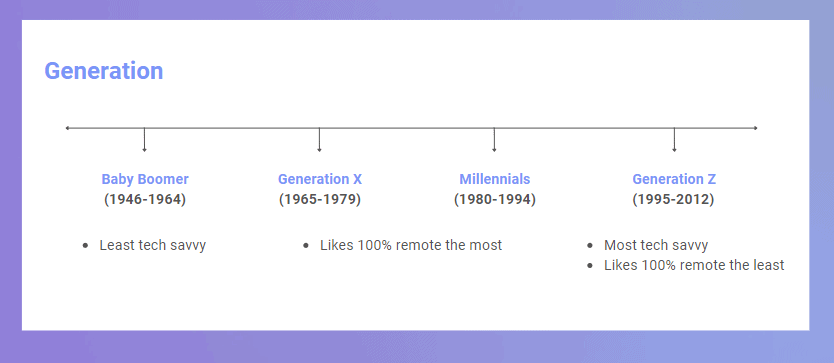
On the other hand, GenZ employees may not be as enamored with remote work as some may think. Despite being digital natives, GenZ often seeks more in-person interaction and mentorship opportunities. According to a Business Insider article citing a national work-from-home survey by economists at three universities, “less than 25% of 20-somethings who can do their jobs remotely want to do so full time. That's compared to 29% of employees in their 30s, 33% in their 40s, and 41% in their 50s and early 60s.”
Generation Lab, a research firm, also polled college students and recent graduates and found that 40% prefer fully in-person work. This was gravely different from how the rest of the generations feel about remote work, where just 12% of all office workers want to return to the office full-time, according to a survey by Slack.
Tips for Employers:
- Offer extra training and resources to help Baby Boomers and GenX feel more comfortable and enabled to use technology in your workplace.
- Find ways to build in-person interaction and mentorship opportunities for GenZ employees.
2. Career Experience
Another important factor to consider, regarding employee perceptions of hybrid or remote work, is career experience. From those who are fresh out of college to those who are subject matter experts in their field, the level of experience a person has can impact their experience of remote and hybrid work and impact the support they may (or may not) need from their employer.
Less experienced employees may have very little job experience in their specific field. Perhaps they are recent graduates diving into their first real position with timelines, deliverables, and performance metrics. These workers may require more hands-on training and guidance to develop their skills and become proficient. They may need more face-to-face interaction and mentorship to feel comfortable working independently. They likely will struggle with the isolation of remote work, which could impact their performance and job satisfaction.
Experienced employees, on the other hand, those that likely have five or more years of experience in their field, are more likely to have sufficient knowledge to work independently. Oftentimes these workers may require less supervision or training and feel more comfortable working independently than their less experienced counterparts. For those with more years under their belt, remote or hybrid work may even provide greater work-life balance as they have already established themselves in their field and may have less to prove.
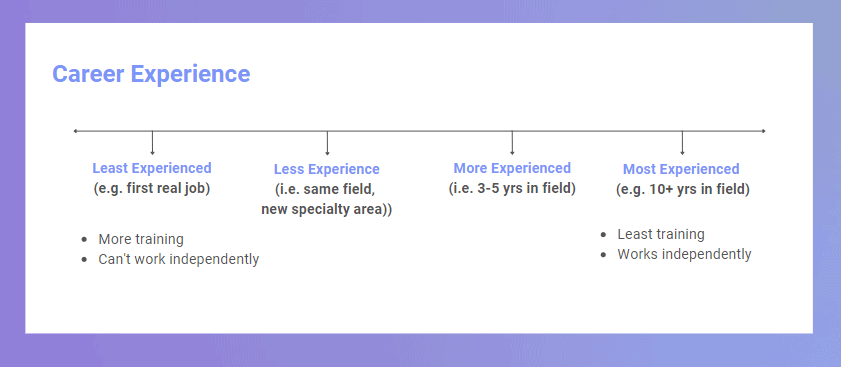
Tips for Employers:
- When working with less experienced employees, communicate your expectations clearly – they may need more explicit guidance and training than more experienced workers in the same field.
- Create teaching moments by pairing a less experienced worker with an experienced colleague to work on a shared project.
3. Tenure with Employer
An employer’s tenure with an organization is another key factor that can impact their experience of hybrid or remote work. Those who have been with a company for a longer time (e.g., 5+ years) may have more historical knowledge of the company than those who are equally experienced in their fields but newer to the organization.
Tenured employees may have already built strong working relationships with colleagues and stakeholders across the organization, making it easier for this group to work successfully from anywhere. Additionally, tenured employees may have a greater level of knowledge and expertise about their employer, from its people, products, and work culture, to the organization’s processes (i.e., how to navigate internal barriers), technology (i.e., shortcuts or limitations that may exist), office politics (i.e., who always has reservations vs. who gets things done), and dead-on-arrival ideas (i.e., things that didn’t work in the past which now have a negative cultural stigma). This organization-specific experience can make them more confident in their ability to work from home or offsite because they have strong relationships and networks within the organization that give them an insider’s advantage.
Employers may have greater trust and confidence in their long-term employees, making it easier to implement flexible work arrangements. If an employee has a strong track record of meeting deadlines and producing high-quality work, the employer might be more willing to accommodate their request for remote work.
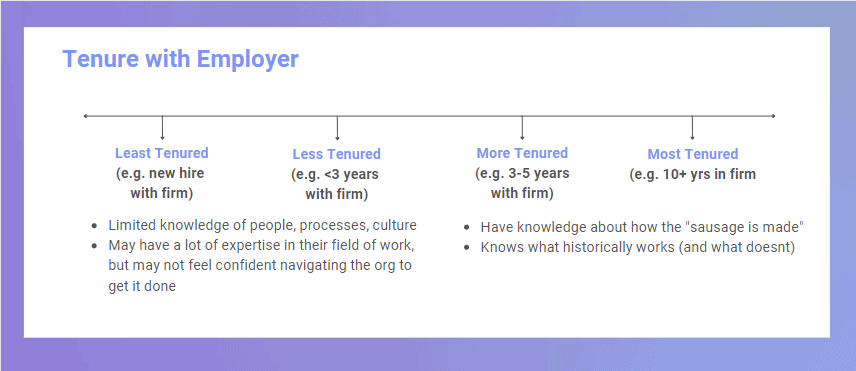
On the other hand, while new hires or employees with shorter tenures may feel positively toward a remote or hybrid environment, they may struggle to get up to speed and feel fully confident and enabled to do their work. New employees lack the advantages that come with time. They may need to work harder (or be more intentional) to develop strong working relationships and networks in their department and with others across the organization. Finding a sense of belonging may take more work and time for newer workers.
Tips for Employers:
- Brainstorm ideas to help new employees make connections and establish their network across your organization.
- Consider offering hybrid or remote work as a benefit for long-term employees. The ability to work from home some or all of the time is, in this case, a retention tool.
4. Leadership Responsibilities
Lastly, whether an employee has leadership responsibilities can impact their experience of hybrid or remote work. Employees with direct reports are responsible for setting the tone, creating and enforcing policies and expectations, and ensuring their teams work efficiently and effectively. This can be a source of stress and pressure when team members face conflicts or difficulties. At the same time, managing people can also be a motivator and source of pride, especially if the team is cohesive and successful.
When implementing hybrid or remote work, businesses should not neglect nurturing, rewarding, and recognizing their leaders. They carry a lot of responsibility on their shoulders, and as culture carriers within their companies, these leaders’ attitudes and beliefs trickle down to their teams and make an impact. Just like other staff, employers should give leaders access to professional growth and development (training, mentoring programs, networking events, access to senior leaders, etc.) If your leaders are fully remote or have a hybrid schedule, providing for and protecting opportunities to develop new skills and advance their careers is important.
The Art of Leading Teams Wherever Work Gets Done

PART THREE
Reimagining the Onboarding Experience
for Hybrid & Remote Workers
Tips for onboarding remote workers, from what to do before their first day to 30-60-90 day plans, the buddy system approach, and more!
Now that the pandemic has normalized remote work and new technologies have emerged, Hawaii companies have widened their talent pools and are hiring people on the mainland to work remotely with greater ease. Yet, a new problem has surfaced. How do businesses effectively integrate remote employees into their work culture and organization? How do managers ensure their teams work well together even if they're not all in the same office? It starts with rethinking the employee onboarding experience for remote workers.
Onboarding a remote employee from across the Pacific Ocean differs from onboarding someone who lives and works in Hawaii. There are unique challenges and obstacles to creating a positive employee experience.
What is employee onboarding?
Employee onboarding is the strategic process of integrating employees into the organization. Too often, managers mistake employee orientation for onboarding, so let's quickly examine and review the differences. Employee orientation is a single event during the first week of the job. It's usually one-size-fits-all and is owned and led by Human Resources (HR). Meanwhile, onboarding delivers role-based information to employees, a process the hiring manager typically owns.
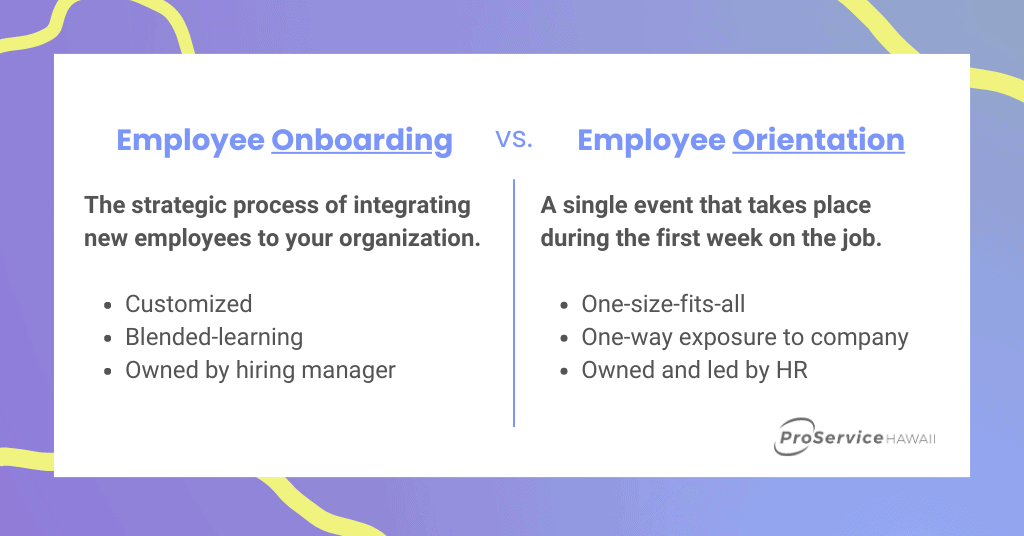 ,
,
New Hire Onboarding Checklists & Templates for Managers
What's the goal of employee onboarding?
Whether you manage an entirely in-person team, remote workforce, or a combination of both, the goals of onboarding a new hire are the same regardless of where work gets done. They include helping your new employee:
- Quickly learn the ropes
- Build strong relationships
- Understand company culture
- Recognize team norms and expectations
- Contribute, lead, and take ownership of their role and work
But while the goals are the same, the onboarding experience can vary depending on where employees work, even from day one.
The Disparity from Day One
Let's examine the hypothetical story and employee experience of two new hires, Michelle and Emily. Both new hires at a marketing firm based in downtown Honolulu will start on the same day. Michelle is a marketing generalist who will be working from the agency's Honolulu office. At the same time, Emily is an SEO wizard and digital specialist of similar age and experience as Michelle but living and working from Seattle.
 Consider both of their first days. On Michelle's first day, she goes into the office to meet her co-workers for the first time. On her way to work, she stops by Leonard's Bakery to pick up a box of malasadas to share with her new team. While IT helps her get situated at her permanent desk, her teammates hang around her cubicle. They eat hot malasadas, give her company swag gifts, and exchange small talk, which includes work-related tips Michelle should know about. At 8:30 am, they all head to the conference room for their morning huddles, where they will meet their new colleague Emily from Seattle. Now let's compare and contrast Emily's first day of work – and how it might look differently.
Consider both of their first days. On Michelle's first day, she goes into the office to meet her co-workers for the first time. On her way to work, she stops by Leonard's Bakery to pick up a box of malasadas to share with her new team. While IT helps her get situated at her permanent desk, her teammates hang around her cubicle. They eat hot malasadas, give her company swag gifts, and exchange small talk, which includes work-related tips Michelle should know about. At 8:30 am, they all head to the conference room for their morning huddles, where they will meet their new colleague Emily from Seattle. Now let's compare and contrast Emily's first day of work – and how it might look differently.
 On the same morning, three hours earlier on Pacific Time, it's Emily's first day too. Emily travels from her bedroom to her home office. At 8 am, she unboxes the laptop she received from the agency in the mail the previous day. Once she's managed to log in, she reads an email from her Hawaii manager with the subject line, “Welcome, Emily!” The email details her first week, the tools and platforms she'll need to ramp up on, and includes a lengthy bulleted list of things to know and documents she needs to read. Emily reads and re-reads the email to ensure she's absorbed everything before logging into Zoom to meet her new team virtually.
On the same morning, three hours earlier on Pacific Time, it's Emily's first day too. Emily travels from her bedroom to her home office. At 8 am, she unboxes the laptop she received from the agency in the mail the previous day. Once she's managed to log in, she reads an email from her Hawaii manager with the subject line, “Welcome, Emily!” The email details her first week, the tools and platforms she'll need to ramp up on, and includes a lengthy bulleted list of things to know and documents she needs to read. Emily reads and re-reads the email to ensure she's absorbed everything before logging into Zoom to meet her new team virtually.
Business leaders must understand that remote workers will face unique challenges during onboarding and throughout their tenure with your organization. By 8:30 am, Michelle is already interacting with half a dozen co-workers and beginning to pick up on company culture cues. Half an hour into the workday, Emily is already at a disadvantage — she's dependent on scheduled Zoom meetings to engage her co-workers and lots of written documentation to sort through on her own. This is one example of remote workers' difficulties when most of their co-workers are in-person or hybrid.
Now let's quickly consider John, a remote manager in California. John is an engineer responsible for managing a team of people in Hawaii. The role of a remote manager is even more challenging as they need to understand the company culture and lead their team through it.
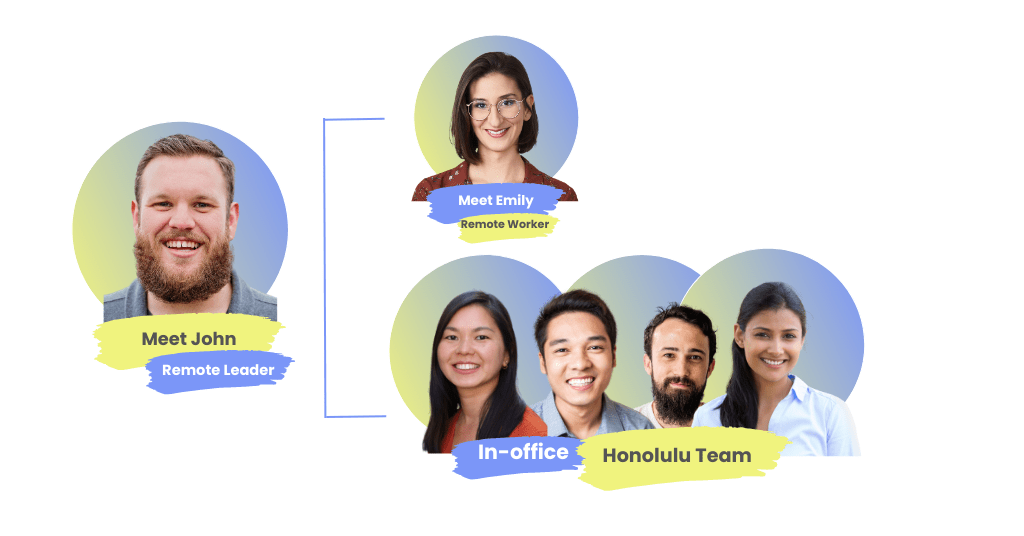
As a leader, John's challenges might include the following:
- Building trust and rapport with his direct reports virtually
- Managing processes and productivity from a distance
- Ensuring that his team understands his leadership style and expectations
- Building strong working relationships with other leaders in the company that are mostly in-person
So, what can Hawaii businesses do to help remote workers integrate and succeed in their new roles? Here are three ideas (and some tips) you can use to help you get started.
#1. Prepare for the Onboarding Process
The first step in onboarding a remote employee is to prepare for your new hire's arrival. This includes mailing all the necessary hardware and equipment (i.e., laptops, monitors, etc.) and ensuring they have access to the software and online platforms your team regularly uses.
Pro Tips:
- Swag it up: Don't just mail them their laptops. Mail branded swag to remote employees, also. Include things like branded notebooks, pens, and more significant items like t-shirts/hoodies, coffee mugs, folders, etc.
- Share the aloha spirit: Encourage their manager and/or in-person team to find their new remote colleague on LinkedIn and send them welcome messages before their first day.
- Get your tech in order: Work with your IT team to document FAQs from a new hire's perspective, from setting up their laptop and getting work email on their devices (if required) to providing them with a tools and platform cheat sheet so they might start learning what resources are available to them to be masters at their work.
#2. Update Your 30-60-90-Day Plan
Creating a 30-60-90 day plan can help your remote employee start quickly and provide structure for their first few months. This plan should include specific goals, milestones, and expectations for their role. If you intend to have your new hire work on a particular project, scope out the assignment or deliverable in advance and provide enough detail for them to dive into the work.
Already have a general 30-60-90 day template for onsite workers? Consider the minor adjustments you can make to your existing plan to better support new hires by considering the top 10 challenges they face:
- Lack of face-to-face interaction and building relationships with co-workers
- Difficulty adapting to new company culture and norms
- Technical problems and lack of access to resources
- Isolation and feeling disconnected from the team
- Difficulty communicating and collaborating with remote team members
- Fewer opportunities for in-person training and coaching
- Time Zone differences and problems with scheduling
- Challenges in establishing clear expectations and roles
- Unfamiliarity with remote work tools and technology
- Difficulty finding a balance between work and personal life
Pro Tips:
- Bring the team together: Fostering togetherness is essential, especially with a distributed team. If budget allows, invite your new hire to Hawaii for one to two weeks of planning and immersion with your broader team. During these critical weeks, schedule in-person planning meetings and team-building activities from after-hour pau-hanas to half-day offsite activities like volunteering together at a local non-profit.
- Reimagine collaboration: Often, team collaboration occurs while standing around a physical whiteboard, but this setup could do a better job of including your remote employees. Consider investing in a digital whiteboard for your office. Encourage collaboration between onsite and remote workers by making it easier to whiteboard when teams are distributed. Tools like Jamboard or Lucidspark are excellent for sparking creativity and conversation with in-person and remote contributors.
- Schedule virtual huddles: If your workplace is fast-paced and constantly evolving, you should find remote-friendly solutions for promptly informing people. Leverage popular project management tools like Asana or Monday.com. Or try scheduling structured information-sharing meetings between key in-person and remote work contributors. These syncs can be quick (e.g., 15 minutes or less), and the frequency can vary (e.g., daily or bi-weekly). Ultimately, these quick huddles can help everyone stay current with details or conversations that even the best project management tools can only partially capture.
#3. Implement a Buddy System
A buddy system is a practical approach for integrating remote workers into an organization's culture and overcoming the challenges of remote work. It pairs a new remote worker with a Hawaii-based peer or mentor who can serve as a guide and resource. A buddy system can be a great way to help remote workers feel connected and integrated into your company and team culture. Not only does having a designated person to turn to for questions and support help them navigate their new role, but by having regular check-ins and interactions with their buddy remote workers can build relationships with their local peers and better understand the team dynamics. This can help remote workers feel more connected to their team, even when physically apart.
The benefits of improving the onboarding process for remote workers are numerous. It leads to higher employee satisfaction and engagement, and results in improved retention rates and increased productivity. In fact, according to one study, employees are 69% more likely to stay with a company for three years if they experience a great onboarding process.

PART FOUR
Your Role in Doing Hybrid Well
Communication, collaboration, and culture advice to help employees flourish.
Hybrid and remote work can bring many advantages – increased productivity, job satisfaction, and more! But it can also stress workplace systems and relationships and test how information flows through your organization.
According to a recent study conducted by the Hawaii State Department of Business, Economic Development and Tourism (DBEDT), one of the most prominent concerns Hawaii employers expressed about having hybrid or remote workers was its impact on collaboration, communication, teamwork, and company culture. So, what can YOU do to ensure employees flourish in a remote or hybrid setting?
Here are some thought-starters.
1. Establish disciplined communication norms
The “fear of missing out” (or FOMO) is a legitimate concern for many remote employees. A study by Zogby Analytics found that 40% of remote workers worried they were missing critical information from leadership or were receiving essential information too late. When employees work in different states or even offices, it's common for crucial details to take longer to flow through the organization. For remote workers—especially key contributors—this can make staying current on projects or conversations challenging. In-person employees often get access to the latest information first via informal hallway conversations with leaders or peers.
If your workplace is fast-paced and constantly evolving, you may want to spend more time brainstorming solutions for keeping people informed promptly. One idea to try is scheduling structured information-sharing meetings between key in-person and remote work contributors. Depending on how fast-paced the work is, these syncs can be quick (e.g., 15 minutes or less), and the frequency can vary (e.g., daily or bi-weekly). Ultimately, these quick huddles can help everyone stay current with details or conversations that even the best project management tools can only partially capture
AM & PM Meeting Framework
2. Find tools to boost real-time collaboration
Collaboration doesn't have to occur face-to-face to be effective. Still, it can be challenging to encourage when your team doesn't have the tools or technology to collaborate smoothly across multiple locations. According to DBEDT's study, 82% of Hawaii companies that offered remote work invested in communication/collaboration software to help their staff adapt.
In addition to video or messaging tools like Slack or Zoom, Google Workspace products like Google Docs/Slides make it easy to collaborate on critical projects in real time. Cloud-based tools allow multiple people to work on the same document together. Inserting comments or tagging co-workers for feedback is a great way to work together on a project. What if you need an old-fashioned whiteboard brainstorming session? Similarly, investing in a digital whiteboard for your office and using tools like Jamboard or Lucidspark are excellent options to spark ideation and conversation with in-person and remote contributors.
3. Openly celebrate milestones & achievements
Employee recognition programs are an important way for employers to show appreciation for their workers and boost morale. However, despite logging in for around 10% longer than regular office staff, remote workers often feel like they don’t play an active role in everyday team life.
One way to better celebrate remote or hybrid workers is to expand the scope of employee recognition programs. Many employee recognition programs focus on in-person activities, such as employee of the month awards or team outings. But in a remote work setting, it's important to expand the program scope. This could include virtual awards or recognition programs or acknowledging the achievements of remote workers during team meetings. One effective best practice is simply to normalize sending a quick message whenever someone does a great job. Praising remote or hybrid employees in open forums where other colleagues can weigh in with comments and likes is another quick and easy way to celebrate employees – in-person or remotely.

PART FIVE
10 Tips for Managing Remote & Hybrid Teams
Top tips we’ve learned from talking with local businesses and implementing our own set of hybrid policies at ProService Hawaii.
After a few years of remote and hybrid work taking over as the norm, companies large and small have new approaches to make this format continuously work for their teams. While it’s not a one-size-fits-all approach, here are the top tips we have learned from talking with our clients and implementing our own set of hybrid policies at ProService Hawaii. Even if your team has been working remotely or hybrid for a while now, it’s helpful to revisit your policies and procedures often to ensure your employees have continued well-being and efficiency.
Pro Tips:
1. Set clear expectations for hybrid/remote work: If you haven’t already done so, create an organizational guide or policies for hybrid working. Include company expectations on security, home setup, digital tools, response times, and other communication expectations. Keep this information in a central place and include it in your new hire and onboarding experience.
2. Seek feedback on remote or hybrid situations: Employees' arrangements since they started working remotely may have changed, so it's a good idea to get feedback from your employees to see what is working and what can be improved.
3. Review your onboarding experience: The onboarding experience is critical to the success of new team members. Ensure you’ve taken the necessary steps to provide a great onboarding experience by implementing a 30-60-90 day plan, the buddy system, and regular check-ins with new colleagues to help them feel valued and connected.
4. Set aside time in all company meetings to create connections: In Hawaii, we tend to take time to connect instead of jumping right into business. Taking 10 minutes to check in, do an icebreaker, or talk about weekend events can help create feelings of connectivity and decrease the isolation and loneliness associated with remote work.
5. Promote social gatherings outside the office: Social connections and relationships are important, especially in remote and hybrid work settings. As our VP of Client Experience, Michelle Kirk, says “If I know you as a person, I can start to work differently with you in a professional setting.” Take the time to bring your company together by promoting social gatherings—it’s great for morale and the business.
6. Be clear about your KPIs for each team and individual: Don’t let teams work blind. Take the time to meet with teams and individuals to discuss and determine KPIs. When teams actively set KPIs, they are more likely to reach goals.
7. Implement 15-minute huddles to start or end the day: Consider hosting a daily morning standup call to get teams on track with open discussion. Guy Cheney, Senior Engagement Manager at Akamai Technologies, noticed that his team was missing the social component of working in person, so they adjusted their virtual meetings. “We have a short meeting in the morning, and everyone in the group comes together; there’s a finite time, and everyone talks. It starts [with] us all together just like [when] we were at the water cooler. You say, ‘this is what’s going on today, this is the issue I had, and this is where I need help.’ And you go around the team.” Be creative to create a social work environment even when working remotely.
8. Make weekly or bi-weekly 1:1s a best practice: Check in with your employees on a consistent basis and create structured engagements. Michelle Kirk, VP of Client Experience at ProService Hawaii, recommends that leaders “constantly calibrate where people are, give specific feedback, and create consistency to make sure the right conversations are happening.”
9. Look for signs of burnout: Zoom and computer fatigue is real. Like in-person work, employees can experience burnout, especially if the lines are blurred between home and work time. Check-in with employees and ask what their biggest challenges are. You can also suggest shaking up routines, like walking or outdoor meetings.
10. Be aware of proximity bias in performance conversations: Being in the office does not necessarily equate to working harder and producing more value. Instead of evaluating team members on time spent in the office or facetime with leadership, managers should use objective criteria based on merit or outcomes. Learn more: Proximity Bias Is A Real Challenge For Hybrid Teams. Here Are 4 Ways To Avoid It.
A Leader's Guide to Effective 1:1 Meetings
About ProService Hawaii
Since 1994, ProService Hawaii has helped employers hire, manage, and grow their teams with bundled solutions for payroll, benefits, HR administration, compliance, and advice. Serving over 2,500 clients, ProService Hawaii has five offices on four islands and is committed to making it easier to be a Hawaii employer. ProService Hawaii is repeatedly recognized as one of Hawaii’s Top 250 Employers and Best Places to Work. To learn more, visit www.proservice.com or call us at (808) 427-4032 for a free 15-minute HR consultation.